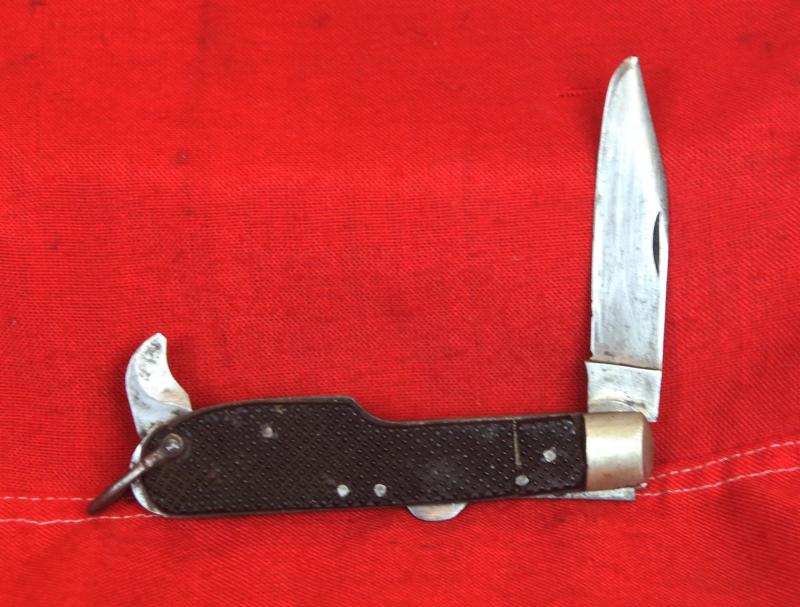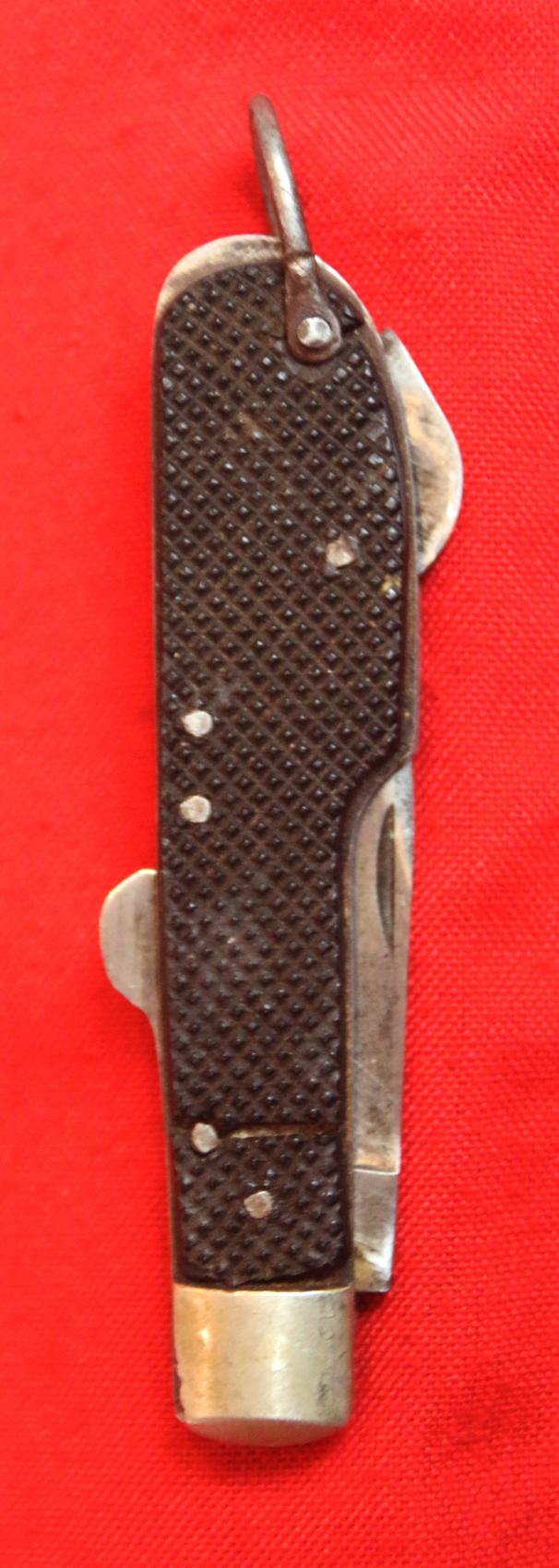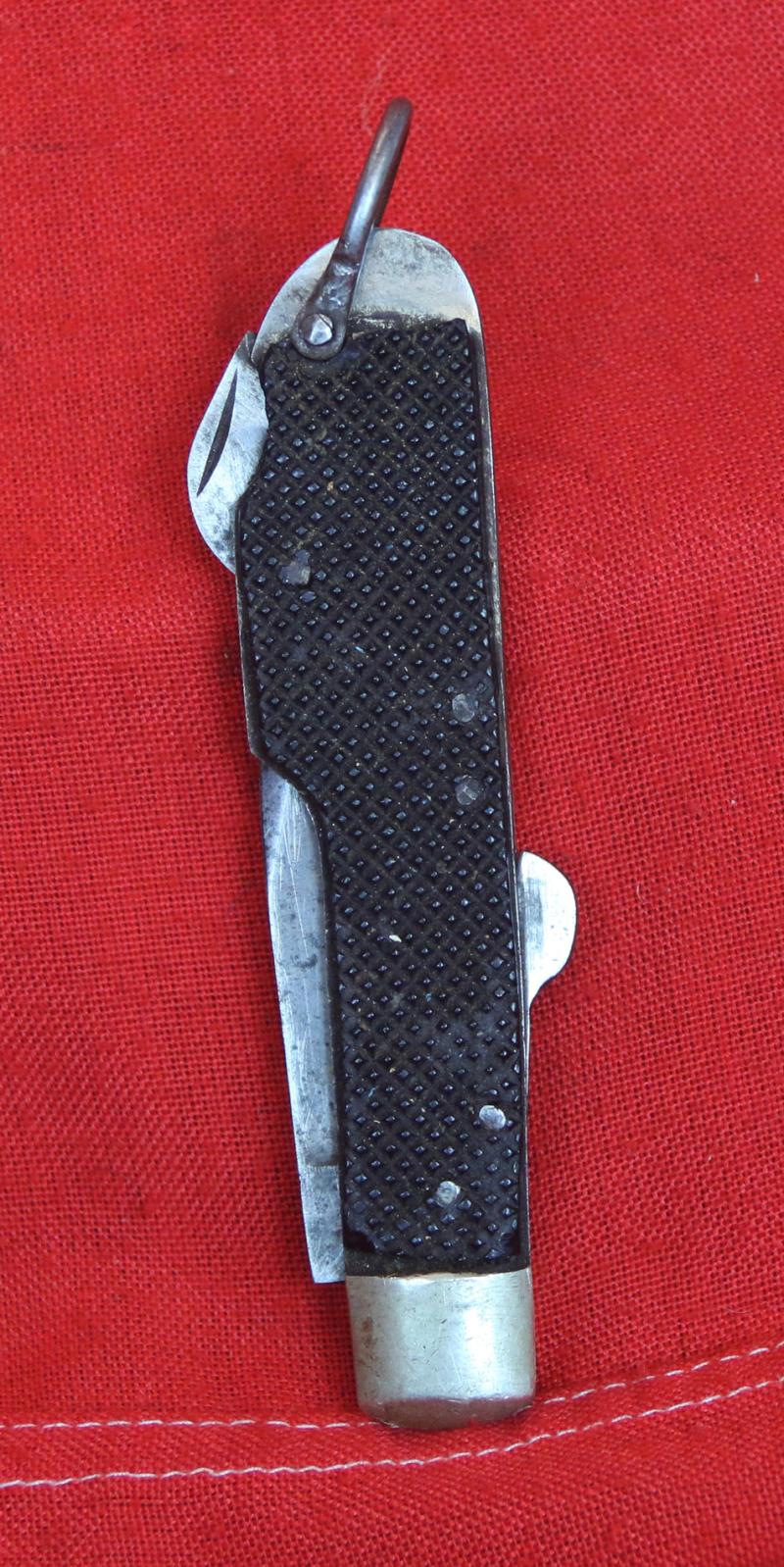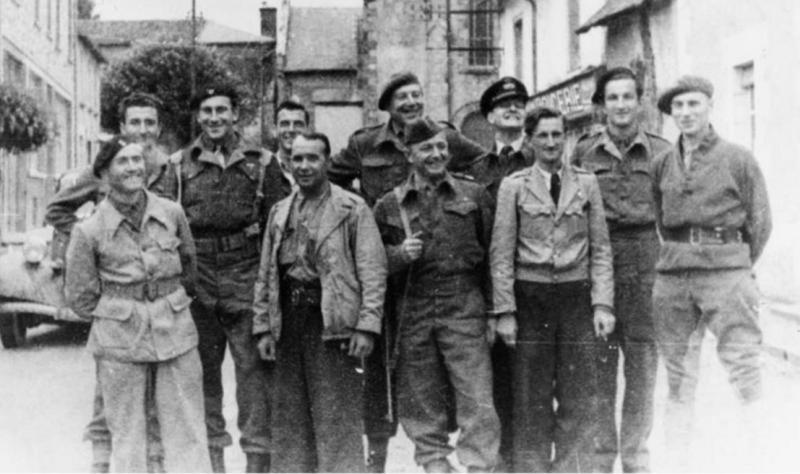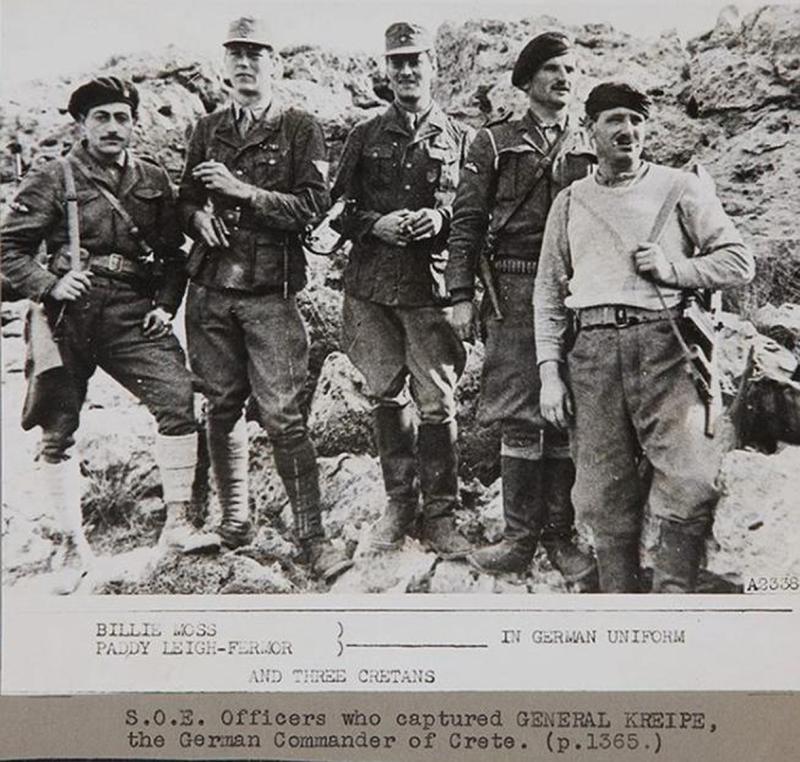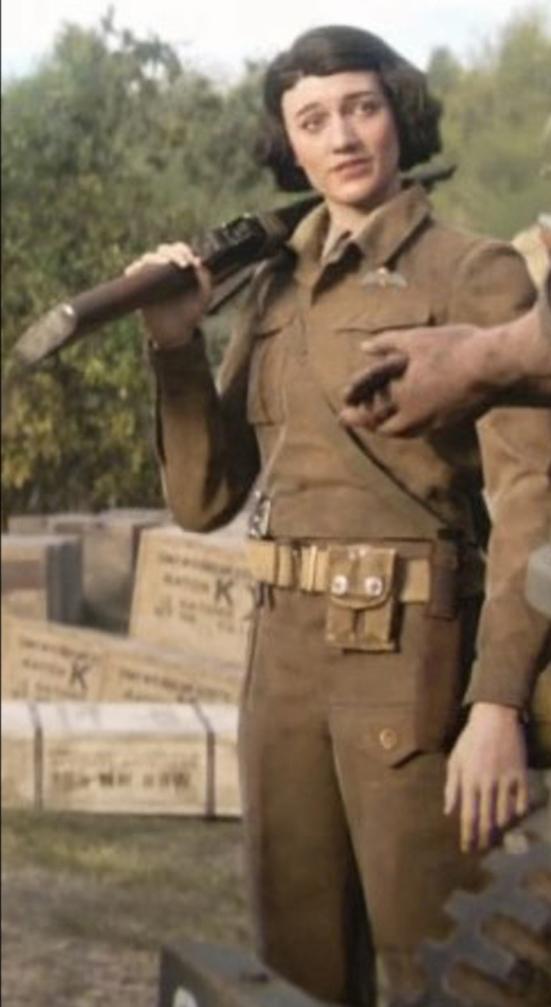A Most Rare Original WW2 SOE/OSS Issue, Clandestine Special Operations Executive Agent's Folding Espionage and Sabotage Clasp Knife With Tyre Slasher.
A slender steel unit with chequered black bakelite scales secured by five steel rivets and belt loop securing pin. Forward section of body is enclosed by short bright steel bolster. Forward section of underside is recessed for stowage of larger blade. Blade when stowed is enclosed by body. A blade release stud is located at back of tang Blade form: larger blade is very slightly recurved and single-edged with a, near Bowie-style, clipped and sharpened false edge. A small but very sharp tyre sabotage hook-like single-edged blade is fitted at "pommel" end of body, with nickel grip plate bolsters. In almost every case over the past 50 years we have sought and found a few of such incredibly intriguing ‘special services’ clasp knives, the long blade’s have all had numerous hand sharpenings and re-shaping due to their constant use in clandestine operations against the Third Reich occupation forces. In fact almost all examples that survive within clandestine forces museums, The IWM and the like, have the blades in such condition and the grip plates with obvious signs of combat use.
See pages 46 and 47 British and Commonwealth Military Knives by Ron Flook.
S.O.E. operatives had a wide range of equipment to help survive in enemy territory. Specialist jump-suits and personal escape and survival packs were developed by S.O.E.'s own factories.
Agents were carefully prepared for missions. Detailed briefings gave the latest information on the countries and specific locations where they were operating. Cover stories, contact addresses, personal codes and escape routes were provided. S.O.E. s paramilitary teams were given money, food and special military stores to meet individual needs
..
This was the knife issued to agents, initially in order to cut the shroud of the parachute, but from thenceforth as a universal espionage knife blade. The second blade is a sabotage tyre slasher.
The Special Operations Executive (SOE) was a secret British World War II organisation. It was officially formed on 22 July 1940 under Minister of Economic Warfare Hugh Dalton, from the amalgamation of three existing secret organisations. Its purpose was to conduct espionage, sabotage and reconnaissance in occupied Europe (and later, also in occupied Southeast Asia) against the Axis powers, and to aid local resistance movements.
Few people were aware of SOE's existence. Those who were part of it or liaised with it were sometimes referred to as the "Baker Street Irregulars", after the location of its London headquarters. It was also known as "Churchill's Secret Army" or the "Ministry of Ungentlemanly Warfare". Its various branches, and sometimes the organisation as a whole, were concealed for security purposes behind names such as the "Joint Technical Board" or the "Inter-Service Research Bureau", or fictitious branches of the Air Ministry, Admiralty or War Office.
SOE operated in all territories occupied or attacked by the Axis forces, except where demarcation lines were agreed upon with Britain's principal Allies (the United States and the Soviet Union). It also made use of neutral territory on occasion or made plans and preparations in case neutral countries were attacked by the Axis. The organisation directly employed or controlled more than 13,000 people, about 3,200 of whom were women.
After the war, the organisation was officially dissolved on 15 January 1946. The official memorial to all those who served in the SOE during the Second World War was unveiled on 13 February 1996 on the wall of the west cloister of Westminster Abbey by Queen Elizabeth The Queen Mother. A further memorial to SOE's agents was unveiled in October 2009 on the Albert Embankment in London.3 The Valençay SOE Memorial honours 104 SOE agents who lost their lives while working in France. The Tempsford Memorial was unveiled on 3 December 2013 by Charles, Prince of Wales, in Church End, Tempsford in Bedfordshire, close to the site of former RAF Tempsford.
On 5 May 1941 Georges Bégué (1911–1993), a radio operator, became the first SOE agent parachuted into German-occupied France. The American, Virginia Hall, who arrived by boat in August 1941, was the first woman to serve for a lengthy period in France. Andrée Borrel (1919–1944) and Lise de Baissac (1905–2004) became the first women parachuted into France on 24 September 1942. A typical team of a network consisted of an organiser (leader), a radio operator, and a courier. Agents performed a variety of functions including arms and sabotage instructors, couriers, liaison officers and radio operators. Between Bégué's first drop in May 1941 and August 1944, more than 400 F Section agents were sent into occupied France. RF sent about the same number of agents; AMF sent 600 (although not all of these belonged to SOE). EU/P and DF sent a few dozen agents each.
Some networks were compromised, with the loss of many agents. In particular agents continued to be sent to the "Prosper" network headed by Francis Suttill for months after it was controlled by the Germans and most of its agents had been captured. The head of F Section, Maurice Buckmaster was blamed by many as he failed to see signs that the network was compromised. Buckmasters highly significant no 2 was Vera Atkins, the basis for the character of Hilda Pierce in Foyle's War. { For those interested, Antony Horowitz’s ‘Foyle’s War’ {2002-2015} was one of Britain’s finest ever wartime tv drama series ever made {see Netflix}. It was of such incredibly fine dramatic quality, staring some of The UK’s finest acting talent, that it was cancelled, due to budget cuts, by its broadcaster, twice. For many, the failure of its recognition as to its quality and worth by the TV exec. mandarins, and to thus order its cancellation, is effectively, the highest praise indeed}
Atkins was recruited before the war by Canadian spymaster Sir William Stephenson of British Security Co-ordination. He sent her on fact-finding missions across Europe to supply Winston Churchill (then in the 'political wilderness') with intelligence on the rising threat of Nazi Germany.
After the war as well as tracing 117 of the 118 missing F Section agents, Atkins established the circumstances of the deaths of all 14 of the women, twelve of whom had perished in concentration camps: Andrée Borrel, Vera Leigh, Sonia Olschanezky (whom Atkins did not identify until 1947, but knew as the fourth woman to be killed) and Diana Rowden executed at Natzweiler-Struthof by lethal injection on 6 July 1944; Yolande Beekman, Madeleine Damerment, Noor Inayat Khan and Eliane Plewman executed at Dachau on 13 September 1944; Denise Bloch, Lilian Rolfe and Violette Szabo executed by shooting at Ravensbrück on 5 February 1945, and Cecily Lefort executed in the gas chamber at the Uckermark Youth Camp adjacent to Ravensbrück sometime in February 1945. Yvonne Rudellat died of typhus on 23 or 24 April 1945, eight or nine days after the liberation of Bergen-Belsen,30 and Muriel Byck had died of meningitis in hospital in Romorantin, France, on 25 May 1944. Atkins had also persuaded the War Office that the twelve women, technically regarded as civilians, who had been executed, were not treated as having died in prison, as had been originally intended, but were recorded as killed in action.
Atkins' efforts in looking for her missing "girls" meant not only did each now have a place of death, but by detailing their bravery before and after capture, she also helped to ensure that each (except Sonia Olschanezky, unknown to Atkins until 1947) received official recognition by the British Government, including the award of a posthumous George Cross to both Violette Szabo in 1946 and, especially due to Atkins's efforts, Noor Inayat Khan in 1949. (Odette Sansom, who survived Ravensbrück, also received the GC in 1946.) However, when Atkins did confirm that Sonia Olschanezky had died at Natzweiler-Struthof, she failed to pass the information to Sonia's family. Atkins was appointed CBE in the 1997 Birthday Honours. She was awarded the Croix de Guerre in 1948 and made a Knight of the Legion of Honour by the French government in 1987. She died in Hastings Sussex in June 2000 aged 92.
4 3/4 Inches fully folded, naturally in combat service used condition, entirely as to be expected, the grip plates are good with small end loss. Considering their service, almost every of the very few examples we have seen in the past 50 years, in or outside of museum collections, have had damage and losses in this area.
Code: 25482


